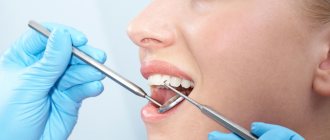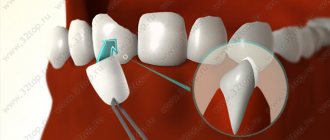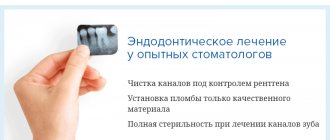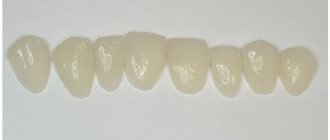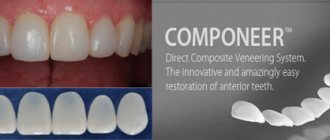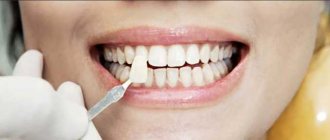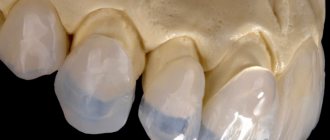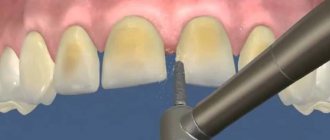Recently, such a quick method of restoring enamel defects and correcting tooth shape as a veneer has been in great demand. These are thin plates designed to be fixed to the front of the tooth. Such microprostheses mask external imperfections and make your smile perfect. One of the most important stages of work is the choice of material for making the product.
Veneers made directly in the laboratory. Result.
Materials
Veneers are made from different materials, with ceramic and composite materials being the most popular.
The choice of material is one of the most important stages in the manufacture of veneers.
Modern composite materials are used to manufacture structures using the direct method.
In this case, it is best to give preference to materials that are the most reliable: not subject to abrasion, color-fast, have a wide range of colors, and are well polished.
Methods for making veneers
According to the manufacturing method, there are two types: direct and indirect. Direct ones are made in the mouth, and indirect ones are made in a dental laboratory.
Depending on the material, there are permanent and temporary. Temporary ones are made of plastic and are used during the production of permanent veneers.
Veneers are made from several materials - ceramic, composite material and plastic.
In our clinic, for the manufacture of ceramic veneers, we use high-quality German E-max ceramics, which have a lifetime guarantee.
For the manufacture of composite veneers, a light-polymer composite is used. This material also serves as the basis for making fillings. Plastic is used to make temporary veneers while permanent ones are being made.
Manufacturing technique and method
Methods for making veneers can be systematized as follows:
- Layer-by-layer application. The veneer is made on platinum foil, which is pressed around a ground tooth on a plaster model. The foil holds the ceramic mass applied to it during firing in the kiln. The dental technician applies the ceramic and fires it directly on the model itself. The good thing about this technique is that it allows you to reduce distortion and shrinkage, as well as the cost of the technology.
- Casting method (injection pressing). Modeling of wax overlays is carried out on a working model, after which they are installed on the sprue and packaged in a special fire-resistant mass. Under vacuum conditions at a very high temperature, after burning the wax, a frame is formed from a ceramic or glass block under pressure. After pressing (casting), the finished plates are painted in the required color. This technique simplifies the process of making veneers and is characterized by high accuracy and excellent marginal fit. Photo: CAD/CAM technology
- Computer modeling using CAD/CAM technologies. The advantage of this technology is that the workpiece can be milled, fitted and fixed in one visit to the doctor. The process of milling the overlay takes no more than ten minutes. The structure is sawed off from the shank, after which it is fitted, polished and glazed. The finished structure is fixed on the tooth with a self-hardening material. Veneers can also be made remotely. The dentist receives an optical impression from the prepared tooth and sends the virtual model to the milling shop by email. After the veneer is made, it is delivered to the clinic by express mail.
Features of making veneers using the direct method
The thickness of the structure manufactured by direct method and manufactured in the laboratory is significantly different.
- The thickness of the veneer made using the direct method depends on the degree of expression of the tooth color.
- The lighter the tooth, the thinner the veneer, and vice versa.
- Consequently, the depth of tooth grinding is determined individually by the doctor and depends on the condition of the patient’s tooth.
The advantage of a veneer made using the direct method is that it is made on the day of visiting the dentist, which is very convenient for patients.
Own dental laboratory
The dental laboratory is the production basis of the orthopedic dentistry department.
And your own dental laboratory is a good reason to brag. This is one of the advantages of the SmileStudio clinic, which we are very proud of. Our laboratory employs the best technicians who do their work efficiently and quickly. Our own dental laboratory makes it possible to minimize the time required to manufacture veneers. Thanks to this, the entire manufacturing process goes very quickly, and the patient becomes the owner of a snow-white smile in the shortest possible time - in just 3-7 days!
The SmileStudio dental laboratory also produces other orthopedic structures (prostheses, crowns, etc.) that meet all the aesthetic and functional requirements of dentistry.
Effective communication between the dentist and dental technician is a key aspect of planning and executing the preparation of severely discolored dental tissues. A well-coordinated team approach allows us to get the job done as quickly and efficiently as possible. In such cases, the creation of functional and aesthetic restorations leads not only to a change in the patient’s smile, but also to a significant increase in his self-esteem. To achieve this goal, the dentist and dental technician must use optimal techniques and high-quality materials, and also have a clear understanding of the final result of the treatment before starting tooth preparation.
Manufacturing and installation
Veneers go through the following stages of manufacturing and installation:
- The initial patient appointment usually includes taking an anamnesis, clarifying complaints, examination, and instrumental examination of the teeth.
- The condition of the gums and plaque is assessed.
- If necessary, X-ray and laboratory tests are performed.
The next step is planning, which involves researching factors such as:
- Gender, age, character of the patient.
- The smile and facial shape are assessed.
- The shape of the line of the gingival margin of the patient’s anterior group of teeth is studied.
- The individual characteristics of the tooth, shape, position, location of contact points, and the direction of the tooth axes are assessed.
- The initial parameters of the restored and intact teeth are measured.
- The size of the veneers is predicted and calculated.
- Demonstration of future restoration on a computer monitor.
Before starting the restoration, it is necessary to carry out professional teeth cleaning and only after that select the color of the veneers being made.
Features of ceramic veneers
Ceramic veneers are one of the most popular dentures. This type of lining has a number of positive aspects. They are installed on the front teeth, but before you decide on this procedure, you should be examined by a doctor, as there are a number of contraindications.
Advantages of ceramic veneers:
- For installation, tooth removal is not required. This allows you to preserve the process of trophism of hard tissues.
- Ceramics is an environmentally friendly material.
- Ceramic products can last more than 10 years.
- Thanks to the light transmission properties, teeth covered with such plates look as natural as possible.
- Products can be installed on cutters.
- With proper care, the material does not lose its shine and does not turn yellow.
Ceramic veneers can be installed on both older and younger people. They are also given to patients who are allergic to other materials. An equally important advantage of ceramic dentures is that if there are defects, they can be easily replaced with new ones. To remove the plate, a laser is used or the cutting method is used with a diamond bur. Veneers can be attached to one tooth or to several at once. The number of products is chosen by the client himself.
Unfortunately, the installation of products cannot be carried out if there are crowns and bulk fillings on the outer part of the tooth. Also, the plates are not intended for attachment to artificial teeth.
Installation steps
Photo: Veneers on a plaster model
- Cleaning the tooth surface from plaque. Products that do not contain oils and fluoride are used.
- Selection of the required shade of filling material.
- Grinding of the front surface of the tooth with preliminary anesthesia. The required amount of enamel is removed from the surface of the tooth. The depth of enamel grinding depends on the thickness of the veneer overlay.
- Taking impressions. To take dental impressions, a special spoon is used, on which a special paste is applied, then the spoon is pressed against the teeth until the mass hardens.
- Based on the dental impressions obtained, a plaster model is cast in the laboratory to obtain an exact copy of the patient’s teeth.
- Making a veneer using a cast plaster model.
- After the doctor has prepared the teeth, a temporary veneer is made directly in the office.
- Trying on the finished veneer after its manufacture. If necessary, adjustments are made, deficiencies are eliminated, and the bite is checked.
- The tooth and veneer are washed under running water and dried with air. Then, to increase the strength of fixation of the plate to the tooth, the doctor etches the enamel with a special gel. Only after this is the veneer fixed to the tooth using special cement.
Cleaning teeth from plaque
Photo: Cleaning teeth from plaque before installing veneers.
It is a must when carrying out any types of restorations.
- Cleansing is performed with a special paste that gently cleanses the tooth of plaque and plaque.
- The dentist applies the paste to a rotating standard polishing disc or brush and cleans.
- To prevent heating, the paste is taken in large quantities.
- In this case, saliva is a kind of saliva ejector.
- After treatment with the paste, the tooth is thoroughly rinsed with water.
Ignoring this procedure leads to a fairly rapid formation of plaque around the lining and pigmented border.
Selecting the shade of filling material
With the patient in a sitting position, the color of the filling material is selected in natural light.
The tooth and reference should be wet when choosing the color, which gives them a natural look.
The choice of shade should be made in natural light.
Tools and equipment for tooth preparation
High-quality grinding of a tooth before covering it with veneer requires the use of modern, highly functional dental equipment.
- The preparation unit must have water-air cooling, a tip washing system, a fiber optic device, a scaler, a 270° rotation of the control panel around the chair, an air-water gun and a control unit for three tips.
- The spittoon must be equipped with an air vacuum group: a dust and saliva ejector, and a built-in clean water system.
- The presence of a lighting device - a reflector, creating a uniform illuminated field with clear boundaries.
- Equipping the dental chair with a silent electromechanical lift makes it possible to treat the patient in a lying position with four hands.
Is it worth getting veneers on your teeth?
In the modern world, every second person wonders whether it is worth getting veneers?
Veneers have many advantages over other types of dental restoration. First of all, they are durable. Your snow-white smile will last for many years, which will make your life much easier. This is the fastest way to correct aesthetic problems, without wearing braces.
If you want a snow-white smile that will look natural and last for many years, then veneers are exactly what you are looking for. All that's left is to find good dentists. Our clinic will help you with this!
SmileStudio employs only highly qualified specialists who do their work quickly, efficiently and at the best prices! Trust our specialists and you will get a perfect smile for many years.
Flaws
Some patients ask for temporary veneers, which is impossible to do, since the teeth will no longer be the same.
To install the onlay, a thin layer of enamel is ground off from each tooth. If this is not done, the tooth will look too prominent.
Other negative points include:
- Onlays only change the appearance of the tooth, but do not make it stronger.
- If veneers are not properly used and cared for, they can peel off or break.
- Composite linings have a short service life. They have to be changed every 5 years.
- The high cost of veneers scares away potential clients.
Layer-by-layer method
In this method, plates are made from platinum foil, whose thickness is 0.020-0.025 millimeters.
The foil is pressed around the prepared tooth on a plaster model. The specialist applies ceramic mass to the model and fires it. The foil holds the ceramics during the firing process, which prevents possible distortion and loss of the desired shape. The model is then sanded and finishing touches are made so that the veneer can be seated on the intended tooth without any problems. This technique is economical because it does not require the use of expensive platinum foil. Therefore, manufacturing the structure will not cost a lot of money.
Veneers contraindications for use
Contraindications to the installation of veneers may include:
- bruxism (a person periodically clenches his teeth during sleep - grinding);
- the plates are attached to the tooth enamel, and its insufficient volume can serve as a contraindication;
- teeth have not erupted sufficiently;
- certain pathologies in the bite (for example, direct or deep bite);
- thin enamel, which leads to frequent chipping in large areas;
- presence of caries with complications;
- the existence of periodontal disease, periodontitis or gingivitis (first you will need to undergo certain treatment);
Other contraindications to the installation of veneers may include fragility of the teeth or the presence of large fillings. Some types of plates are made of durable material, but this is not enough to protect the tooth from damage. In such cases, it is better to use dental crowns.

